If you want to rip some wicked power chords and guitar solos, you need to dial in just the right Ibanez Tube Screamer settings! In this article, I’ll give you everything you need to sound like the pros!
Keep on reading because you’re really going to love this!
You can use the table of contents below to take you to the area that interests you. Click on the little box to open it, and then click on the section of the article you want to read, or you can read from start to finish if you want the full Tube Screamer experience!
The Short Answer
The best Ibanez Tube Screamer settings for overdrive & distortion depend on your playing style, the type of music you play, and the guitar, amplifier, and other effects pedals you use. The Tube Screamer’s Overdrive, Tone, and Level settings can give you a clean boost, crunch, distortion, and fuzz tones for Blues, Rock, Metal, and Country music.
Keep On Reading (Below) To Learn More
What The Tube Screamer Controls Do
The Tube Screamer has three knobs that can be adjusted to get any sound, from a clean boost to fuzz and everything in between. Deluxe models have additional settings (more on that below).
The three controls are labeled Overdrive, Tone, and Level from left to right.
Turning each knob clockwise makes its effect on your guitar’s audio signal more prominent.
Overdrive
The Overdrive control adjusts the amount of distortion in the signal. Changing this control in small increments can make a significant difference in the overall sound of the unit.
Tone
The Tone control changes the amount of “high-frequency contour” of the guitar’s overall sound. Lower settings make it mellower, while higher settings dial in more treble and bite.
Level (Balance On Some Original Models)
Note: This knob is labeled “Level” on the newer models (like the pedal controls shown in the next section) and “Balance” on some of the original TS 808 Tube Screamers.
The Level control adjusts the output level of the distorted signal but does not change the normal signal level. This makes it useful for balancing the “dry” signal with the pedal switched off with the “wet” (distorted) signal when the pedal is on.
Tube Screamer Settings
The knob settings in the tables below represent the hands on a clock, so 7 o’clock (7:00) is the lowest setting, 12 o’clock (12:00) is the middle setting (straight up), and 5 o’clock (5:00) is the highest setting.

General Settings
I use these four basic settings on my Ibanez TS-808 Reissue Tube Screamer. You may need to adjust each setting according to where the pedal is in the signal chain, the guitar you are using, and the amp you are playing through.
They are essentially the same as the settings I use for my Ibanez TS-9 pedal. After all, the two types of pedals sound very similar. The TS-808 is mellower and more balanced, while the TS-9 has a little more of a trebly bite to it for a modern sound.
Everyone’s idea of what these settings should sound like is a little different, but this will get you started.
| Setting | Use | Overdrive (O’Clock) | Tone (O’Clock) | Level (O’Clock) |
|---|---|---|---|---|
| Clean Boost | Rhythm & Lead | 7:00 to 8:00 | 11:30 to 12:30 | 12:00 to 3:00 |
| Crunch | Rhythm & Lead | 9:00 to 12:00 | 2:00 to 4:00 | 1:00 to 4:00 |
| Distortion | Lead | 3:00 to 5:00 | 9:00 to 10:00 | 1:00 to 4:00 |
| Fuzz | Lead | 6:00 to 7:00 | 12:00 to 3:00 | 1:00 to 4:00 |
Settings Of The Stars
Here are the Tube Screamer settings of well-known guitar players who have used TS-808, TS-9, and TS-10 pedals.
I obtained this information from a series of Internet searches, so I can’t guarantee the accuracy as an absolute. I used photos of the artists’ pedalboards whenever possible.
They all sound like a reasonable approximation to me. Try them and see what you think.
| Guitarist | Overdrive (O’Clock) | Tone (O’Clock) | Level (O’Clock) |
|---|---|---|---|
| Stevie Ray Vaughan | 8:30 to 9:00 | 5:00 | 3:00 to 5:00 |
| Joe Bonamassa | 1:00 | 1:30 to 2:00 | 3:00 |
| Kirk Hammett | 5:00 | 5:00 | 1:00 to 2:00 |
| The Edge | 2:00 | 11:00 | 12:00 |
| John Mayer | 1:00 | 1:00 | 1:00 |
You may think Stevie Ray Vaughan cranked the overdrive knob, but he used the Tube Screamer (either a TS-9 or a TS-808) as a clean overdrive and made his amps do a lot of the work.
What Is The Ibanez Tube Screamer?
The Ibanez Tube Screamer is a pedal (stomp box) that “boosts” your guitar’s audio signal to add overdrive, crunch, and distortion to your sound.
Technically, it is classified by Ibanez as an overdrive unit, not a distortion pedal. The user manual says it ” delivers that warm, natural tube overdrive sound previously unattainable by conventional units.”
However, the Tube Screamer can create distortion and fuzz sounds, especially if your guitar has high-output pickups (humbuckers) or active electronics. High-gain amplifiers can also add distortion to the final sound.
The Ibanez Tube Screamer can be used in the front end of your guitar’s signal chain (between your guitar and amp) to add clean boost, crunchy overdrive, distortion, and fuzz to your rhythm or lead sound. More about the pedal’s placement can be found below.
Types Of Tube Screamers And Buyer’s Guide
Although the Ibanez Tube Screamer has gone through a series of evolutions over the years, its overall control layout and functionality haven’t really changed, except for some added extras on the deluxe models.
TS-808
The TS808 appeared in the late 1970s. The first (vintage) units are considered to have the best sound and are very costly to buy used. If you’re lucky enough to have one of the originals, guard it closely!
While almost all TS-808s sound great, there were units made for non-US markets with a narrower green box and a different circuit using two 1458 chips functioning as dual op-amps. The Level knob on these units was labeled “Balance.”
The currently available TS-808 units are re-issues of the original tube Screamer and sound great, but not as good as the first vintage models.
This is the model I mostly use, which I prefer over the sound of the TS-9. It has the same JRC4558D IC chip and analog circuitry as the original (vintage) Tube Screamer.
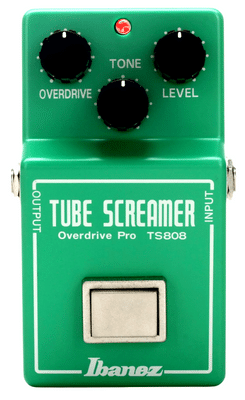
Click Here To Check Price On Amazon
Tube Screamer Mini
The Ibanez Tube Screamer Mini is essentially the TS-808 re-issue built into a smaller case to take up less space on a pedalboard. Because of its size, it does not have room for a battery and has to be run with a power adaptor (Ibanez AC509 or equivalent) or an adaptor that connects it to an external 9-Volt battery.
I gave this mini pedal a try on a pedalboard, and it sounds just like the re-issue TS-808 units. It is a real space saver, and I like the big Overdrive knob, which makes it easy to add or remove distortion during a performance.
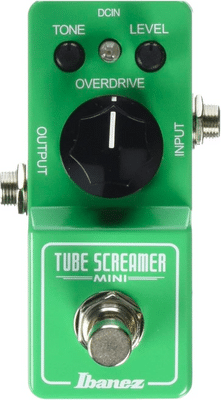
Click Here To Check Price On Amazon
Ibanez TS-808DX
The Ibanez TS-808DX is an enhanced version of the TS-808 that gives you some cool options. It’s like a TS-808 with a boost control that can be added to the circuit with a separate switch.
A mini toggle switch on the pedal allows you to put the boost before or after the Tube Screamer for some very cool sounds! Placing the boost before the overdrive will increase the pedal’s distortion. Putting the boost after the overdrive will boost the overdrive’s output volume, making it ideal for guitar solos.
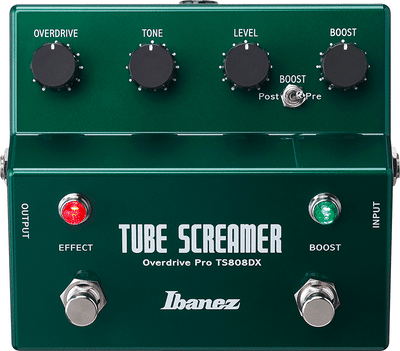
Click Here To Check Price On Amazon
TS-9
The Ibanez TS-9 is the newer version of the TS-808. It essentially has the same controls: Drive (instead of Overdrive), Tone, and Level. It does not have the same sound as the TS-808 and Tube Screamer Mini, but it is close.
It was designed to have a more modern “edgier” sound than the TS-808, which gives a “creamier” and more mellow sound. I don’t use it as much as the TS-808.
It all comes down to which sound you prefer, modern TS-9 or old-school TS-808.
Some of the greats, like Stevie Ray Vaughan, have used it, so it’s not a second-class pedal!

Click Here To Check Price On Amazon
Ibanez TS-9DX (Turbo)
This is the pedal that is popularly known as the TS-9 “Turbo.” It has the usual three knobs, plus a Mode switch that allows you to select Turbo, Hot, +, and TS9 modes, making it four pedals in one!
The best way I can describe it is like playing through an Ibanez TS-9 with the capability to add three boost modes, each hotter than the other. So, it’s like a TS-9 on steroids, which gives you some “over the top” sounds with enhanced harmonics.
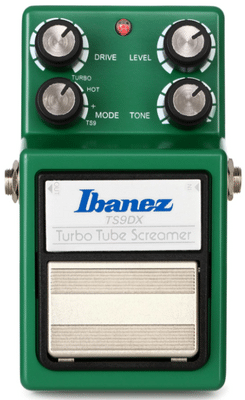
Click Here To Check Price On Amazon
Ibanez TS-10
Ah, now we come to the TS-10, what many players consider the “holy grail” of tube Screamers.
The Ibanez TS-10 was another variation of the Tube Screamer made in Taiwan in the 1990s. It used the JRC4558D IC chip and analog circuitry, just like the original (vintage) Tube Screamer or the MC4558 chip, depending on when you purchased one.
The TS-10 has that sweet bluesy sound and has been used by Stevie Ray Vaughan and John Mayer. This pedal is hard to find and can cost hundreds to thousands of dollars in boutique pedal stores, depending on the unit’s IC chip and overall condition.
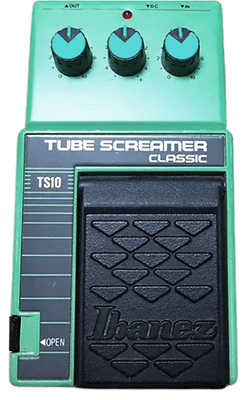
Buyer’s Guide And Best Value For The Money
Each pedal is a great unit, but which is the best overall value?
TS-808 Series
If you’re going for a more classic blues sound, the Tube Screamer Mini is cheaper, but you must add an external power supply. You get the same sound as the full-size TS-808.
The TS-808DX is the way to go if you want the fully controllable boost circuit.
If you can find an original (vintage) TS-808 or a TS-10 and have the cash to burn, you will be a very happy guitar player!
TS-9 Series
The TS-9 will cost you less than the TS-808 and is the way to go if you want a more modern sound.
If you don’t mind paying about twenty dollars more, the TS9DX (Turbo) gives you three extra boost options.
Although they’re close, you really can’t get the same sounds out of the TS-9 pedals as the TS-808 series. If you’re like me, you’ll want one of each for your pedalboard, but if you can only afford one, choose wisely!
Price Comparison Table
This table compares the relative price of each unit from cheapest to most expensive.
| Tube Screamer Model | Cost |
|---|---|
| Tube Screamer Mini | $ |
| TS-808 | $$ |
| TS-9 | $$ |
| TS-9DX | $$ |
| TS-808DX | $$$ |
| TS-10 | $$$$ |
The Tube Screamer Mini is the best value for the money, but if you want a more modern sound, go for the TS-9 or TS-9DX.
The TS-808DX will put you in old-school overdrive heaven if you have the money.
If you inherit a load of cash from your rich uncle, look for a TS-10!
What Is The Ibanez AC509 Power Adaptor?
The Ibanez AC509 power adaptor can supply 9-Volts to any Tube Screamer effects pedal.
Note: All the Ibanez Tube Screamer pedals require a center-negative barrel-type power plug. Using a center-positive power adaptor will damage your pedal!

If you have the Tube Screamer Mini pedal an external power supply is required since it does not have a battery inside. The Mini pedal can be connected to the power supply on your pedal board, with a separate power supply (like the one in the photo below), or with a battery snap connector.
The Ibanez AC509 is difficult to find, but if you need an external power supply, here’s one from Amazon. It also has the battery snap connector to use a 9-Volt battery externally for the Mini Tube screamer, which is good when no AC power outlet is available. It also comes with a 240-Volt AC adaptor.
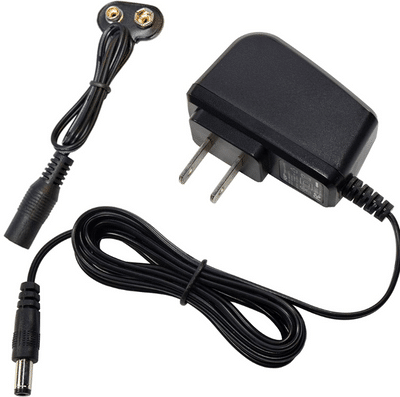
Click Here To Check Price On Amazon
What Is The Ibanez Tube Screamer Amp?
The Ibanez TSA15H is an all-tube 15 Watt amplifier with a Tube Screamer circuit built into its front end that spikes the two 12AX7 preamp tubes. The amp section has two 6V6 power tubes.
It has the standard Overdrive, Tone, and Level Tube Screamer controls and amplifier Treble, Bass, and Volume adjustments.
The TSA15H has a Tube Screamer on/off switch and a 6dB boost switch that can also be operated with an optional footswitch.
It’s switchable from a 15-watt pentode down to a 5-watt triode power output.
The amp head has a separately available matching Ibanez TSA112C open-back speaker cabinet with a 12-inch Celestion Seventy 80 speaker that handles 80 watts of power at 8 ohms.
It is no longer in production but can be found online and in boutique amplifier shops.


Where To Put A Tube Screamer
The Ibanez Tube Screamer is a pedal (stomp box) that goes between your guitar and amplifier, also known as the “front end” of your signal chain. You want it to “spike” the preamp section of your guitar amp, pushing it into overdrive and clipping the signal to produce a dirty sound with more sustain.
Never put an overdrive, distortion, or fuzz pedal in your effects loop! Putting a pedal in the effects loop places it between your guitar amplifier’s preamp and amp section.
Here is where I put my overdrive, distortion, and fuzz pedals on my pedalboard.
guitar -> Tuner -> Wah Wah Pedal -> Compressor -> Overdirve/Distortion -> Modulation (tremolo, chorus, phase shifter, & flanger) -> Reverb/Delay -> amplifier input jack
Putting the modulation, reverb, and delay pedals in the effects loop can make them sound better. See What Is A Guitar Stomp Box – Attractive, Little, Tantalizing, for more info.
Tube Screamer Stacking
Pedal stacking refers to using more than one type of pedal simultaneously, usually two overdrive or distortion pedals connected in the signal chain so that one feeds its signal directly into the other.
For example, Trey Anastasio uses two Tube Screamers on his pedalboard, either TS-808 or TS-9 units. The first Tube Screamer’s Overdrive knob is set lower, and the second pedal’s Overdrive knob is set higher. Each pedal can be turned on separately, or they can both be turned on (Stacked) together.
And let’s not forget Billy Gibbons, who has famously stacked as many as six Bixonic Expandora distortion pedals to obtain his deliciously saturated trademark sound! He really is the “king of tone.”
Advantages Of Using An Overdrive Pedal

- Great for power chords for solos
- Adds sustain to whatever you play
- Enhances note harmonics
- Can make a small amplifier louder and sound bigger
- Gives your playing that “cool factor”
Disadvantages Of Using An Overdrive Pedal

- Adds noise to your signal
- Can make individual notes more difficult to hear clearly
- Can damage the speaker in a low-powered amplifier
Are Tube Screamers Designed For Heavy Metal?
If you’re a heavy metal monster, a Tube Screamer may not be the ideal pedal for you, at least not as a first pedal.
Although you can get quite a bit of distortion out of a Tube Screamer, especially if you have a guitar with humbuckers going into a high-gain amp, it won’t really give you the ultra-scooped mids and low-frequency power you need to get that awesome 7-string tone.
It’s not to say that some awesome heavy metal players don’t use Tube Screamers. They have been used by Kirk Hammett, Michael Schenker, and George Lynch, to name a few. A tube screamer can be combined with other distortion pedals to give your rig that extra kick.
Suppose heavy metal is in your repertoire but not first and foremost. In that case, you can get a decent Metal sound using a Tube Screamer in combination with a graphic or parametric equalizer. I have used this approach to play convincing-sounding tunes by Metallica and other Metal bands.
Frequently Asked Questions

Here are some of the questions I get asked about Ibanez Tube Screamer Pedals.
If your question does not appear here, please put it in the comments, and I will get right back to you with an answer.
Is The Ibanez Tube Screamer An Overdrive Pedal?
Yes, the Tube Screamer is an overdrive pedal, not a distortion unit. However, it can be adjusted to distort a guitar signal, especially if the guitar has humbucking pickups or you’re playing through a high-gain amplifier.
Which Is Better, Overdrive Or Distortion?
Neither overdrive nor distortion is better than the other. It depends on which effect best suits a song and your playing style. Overdrive is typically more subtle than distortion and doesn’t push an amp as hard. Distortion is overdrive taken to an extreme and is harsher and less articulate sounding.
If you’re unsure what pedal is best for you, I recommend starting with an overdrive unit. You can add a distortion pedal later.
Do Tube Screamers Work With Solid State Amps?
Yes, they work fine with solid-state amplifiers but may give you a less organic sound than when used with a tube amp.
Is There A Tube Inside A Tube Screamer Pedal?
No, these pedals have solid-state (non-tube) components with an IC chip. They get their name because they are designed to make the notes you play “scream” like it is coming from an overdriven tube amp.
Can An Overdrive Pedal Damage An Amp?
Yes, it is theoretically possible, especially if you have a low-wattage amplifier with a speaker not designed to handle a lot of power. However, it is unlikely.
What Guitarists use A Tube Screamer?
Players like Stevie Ray Vaughan, Eric Johnson, John Mayer, Joe Bonamassa, Gary Clarke Jr, Michael Schenker, Buddy Guy, Trey Anastasio, Kirk Hammett, George Lynch, The Edge, Gary Moore, and Brad Paisley have all used a Tube Screamer. There are too many guitarists to list them all.
Why Is The Ibanez Tube Screamer So Popular?
The Tube Screamer is so popular, especially among Blues and Rock guitarists, because it gives a balanced, overdriven sound that is not too harsh. It responds to a player’s picking dynamics and brings out note harmonics in all frequency registers. The Tube Screamer also works well with other overdrive and distortion pedals.
Final Thoughts

Although the Ibanez Tube Screamer is technically an overdrive pedal, it is very versatile.
The Overdrive, Tone, and Level controls on a Tube Screamer can be set to give you a clean boost, crunch, distortion, and fuzz tones. This makes them useful for playing Blues, Rock, Metal, and Country music.
The best Tube Screamer settings will depend, to a degree, on your playing style and the type of music you play.
There are six Tube Screamer models, each with its unique sound. They are the TS-808, Tube Screamer Mini, TS-808DX, TS-9, TS9DX, and TS-10. Pick the model that best fits the sound of the music you play and your budget.
A vintage Ibanez Tube Screamer, like a first-generation TS-808 or a TS-10 can be difficult to find and vey costly!
Ibanez Tube Screamer mods have become popular because they beef up the gain structure of the pedal and modify its frequency response.
Never put a Tube Screamer in the effects loop of an amplifier. If you have an effects loop, use it to connect your time-based (modulation) effects, reverb, and delay units.
A tube screamer may not be the ideal pedal for heavy metal, depending on your guitar, amp, and the other effects you are using. It’s generally best to use a distortion pedal for metal sounds, although a Tube Screamer can be used in conjunction with distortion.

Related Article ➡ Can You Use Single Coil Pickups For Rock? – Ultimate Guide!
Here is a video from Marty Music comparing the Ibanez Tube Screamer TS-9 to the TS-808. Listen for yourself and let me know which one you prefer in the comment section below!
Tell Me What You Think

Please leave a comment below if you enjoyed this article, have any questions about the Ibanez Tube Screamer, or want to give your point of view. I will be happy to help you.
- Do you have a Tube Screamer? Which one?
- What do you like best about Tube Screamers?
- How do you set your Tube Screamer’s controls?
- What type of music do you like to play with your Tube Screamer?
- After reading this article, are you thinking about getting a Tube Screamer?
- What else is on your mind?

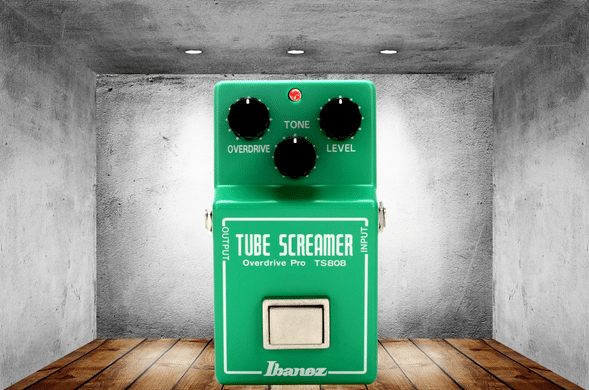

Honestly you make me feel my guitar is not complete without the Tube Screamer. From your description of the Ibanez tube screamer, I know it will give my guitar’s performance a turnaround. From the powerful boost and distortion free tone and wide range of models for one to select from. I will pin this article to come back to it when I am financially ready for Ibanez tube screamer
Hi, Ayodeji
Thank You for your comments!
What type of music do you play? Also, what guitar and amplifier do you have? Based on this information, I may be able to advise you what model Tube Screamer may best suit your needs.
I remember you told me your son plays the guitar as well.
Keep on Playin’
Frank 🎸
Wow! Tube screamers seem like the real answer to controlling one’s sound. Having only three controls to set to bring the exact sound that you desire, is awesome. Being able to adjust the amount of distortion, high frequency contour and the ability to adjust the output level of the distorted signal, is of great value. Having the Tuber Screamer settings follow the hands of a clock makes it easy to use. It is useful that you have provided Tube Screamer settings of well-known guitar players as many like to follow a pro. You have provided many choices and have even gave the range of costs involved. Thank you for such a valuable resource on this topic.
Hi, Toplink
Thank You for your comments!
Did this article convince you to get a Tube Screamer? If so, which model are you thinking of buying?
It’s a great overdrive pedal that works well with single-coil and humbucking pickups!
Please let me know if I can answer any questions about this product.
Keep On Rockin’ 🤘
Frank